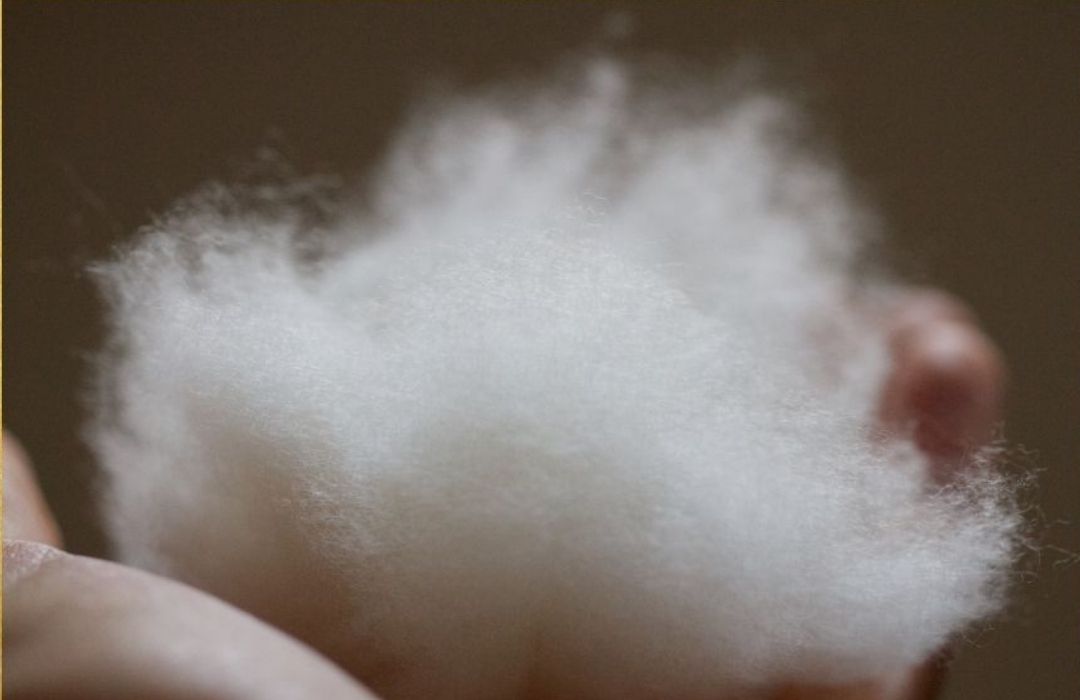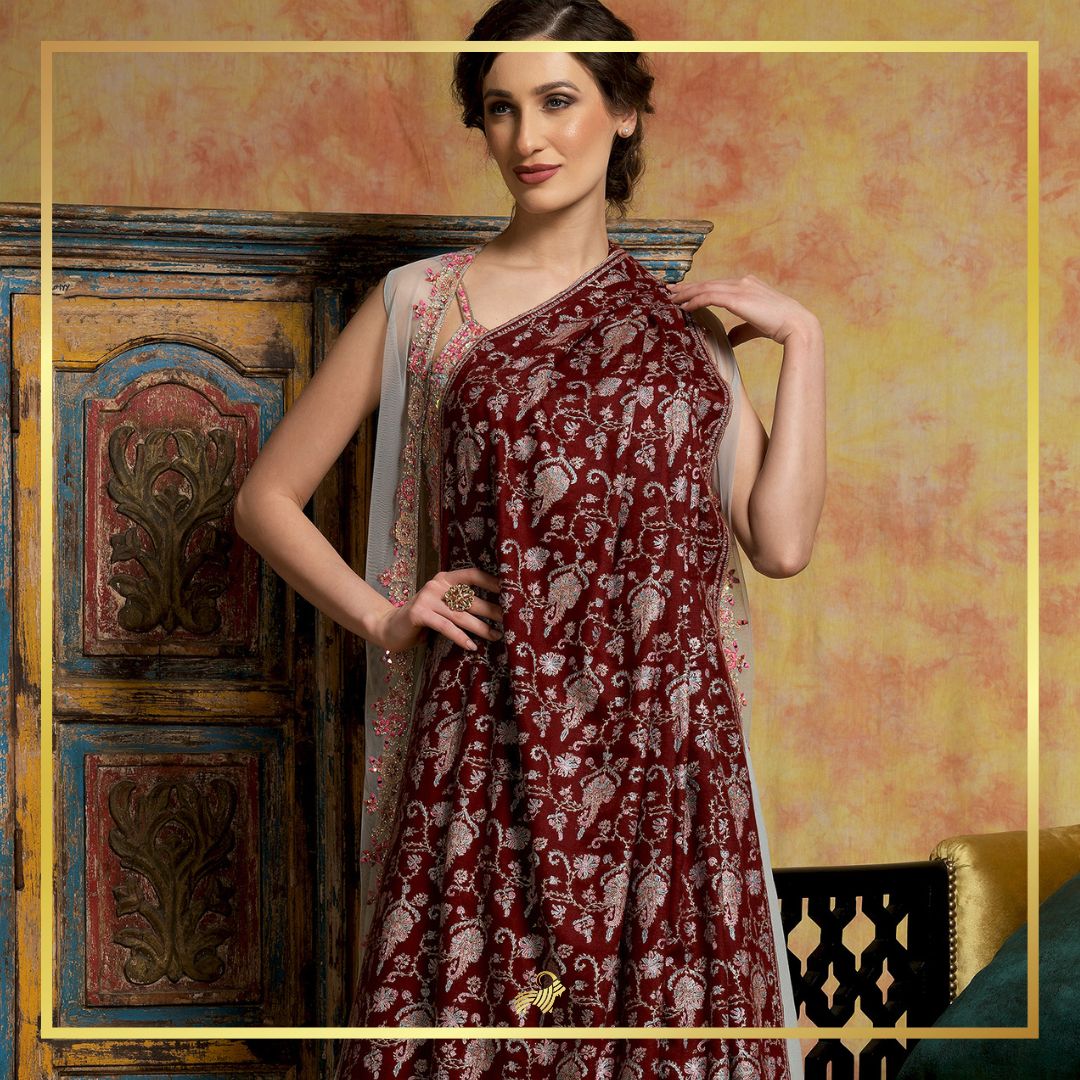Cashmere and wool are both luxurious natural fibers that have captivated the world for their exceptional softness, warmth, and versatility. Derived from different sources, these exquisite materials offer distinct qualities and benefits. And this makes them cherished choices in the realm of fashion and comfort. In this blog, we will explore the characteristics of cashmere and wool. Hence we will compare their strengths, weaknesses, and applications to determine which fiber reigns supreme in the debate of cashmere vs wool. But first, let's know more about these two animal hair categories
What is Cashmere?

Cashmere is a luxurious and prized natural fiber derived from the undercoat of cashmere goats. These goats, native to regions with harsh and extreme climates, have developed a fine and soft undercoat. This is a survival mechanism to endure the cold winters. When temperatures drop, the goats grow this insulating layer of fine hair. And herders comb or shear this hair from the animals during the spring molting season. They carefully process, sort, and spin the collected fiber into yarn. Subsequently, artisans use this yarn to create a wide range of high-quality textiles and garments. Known for its exceptional softness, warmth, and lightweight feel, connoisseurs in the world of luxury adore fashion and comfort. And this makes it a treasured addition to any wardrobe.
Origins and Uses of Cashmere
The process of producing Cashmere is labor-intensive and requires a high level of skill. It involves the careful collection of the goat's raw fleece, followed by cleaning, sorting, and spinning the fibers into yarn. The yarn is then handwoven into exquisite shawls, scarves, blankets, and other textiles. The craftsmanship behind Cashmere production has passed down through generations, making it a cherished and traditional art form in the region.
Versatile Uses of Cashmere
- Shawls and Wraps: Perhaps the most well-known use of Cashmere is in the creation of shawls and wraps. Cashmere shawls are popular for their exceptional softness and warmth, making them a coveted accessory during colder seasons. These shawls come in a wide range of designs, from intricate traditional patterns to modern, minimalist styles. Cashmere shawls are often used to elevate eveningwear and add a touch of luxury to any outfit.
- Scarves and Stoles: Cashmere scarves and stoles are versatile accessories that can be draped elegantly over the shoulders or wrapped around the neck. They are lightweight yet incredibly warm, making them suitable for both casual and formal occasions. Cashmere scarves often feature intricate embroidery or handwoven patterns, adding a touch of sophistication to any ensemble.
- Blankets and Throws: Cashmere blankets and throws are not only functional but also decorative. They can be used to add warmth and style to a living room or bedroom. These blankets are known for their lightweight warmth and can be an excellent choice for snuggling up on a chilly evening.
- Clothing: Cashmere fibers are so fine that they can be blended with other materials, such as silk or cashmere, to create a variety of clothing items. Cashmere-blend sweaters, cardigans, and dresses are popular choices for those seeking both comfort and luxury in their everyday wear.
More uses of Cashmere
- Accessories: Cashmere is used to create a range of accessories, including gloves, hats, and even socks. These accessories provide not only warmth but also a touch of elegance to one's attire.
- Home Décor: Cashmere textiles do not limit to personal fashion. People also use them as decorative elements in homes. Cashmere curtains, cushion covers, and table runners can infuse a room with a sense of opulence and sophistication.
- Gifts and Souvenirs: Cashmere products, with their timeless appeal and cultural significance, make for cherished gifts and souvenirs. People often bring them back from travels as a symbol of the region's artistry and beauty.
History of Cashmere
Cashmere has a rich and storied history deeply intertwined with the Kashmir region, where it was first produced. This exquisite textile is popular for its softness, warmth, and luxury.
The origins of Kashmiri Cashmere can be traced back over a thousand years to the Kashmir Valley in the Indian subcontinent. The name "Cashmere" is derived from "Kashmir," the region where it was traditionally crafted. The Himalayan region of Kashmir provided the perfect environment for the production of this exceptional fabric, as the harsh winters led to the development of a unique and luxurious fiber source.
The source of Cashmere wool is the soft undercoat of the Himalayan goat, specifically the Changthangi goat. These goats have adapted to the extreme cold of the Himalayan winters by growing a fine, insulating underlayer of hair. It is this underlayer, which artisans comb and collect during the spring molting season, that forms the basis for Cashmere shawls and wraps.
The production of Cashmere is a labor-intensive and highly skilled process that involves cleaning, sorting, and spinning the delicate fibers into yarn. This yarn is then woven into shawls, scarves, blankets, and other luxurious textiles. Kashmiri artisans have honed their craft over generations, perfecting the intricate weaving techniques and designs that make Cashmere so highly prized.
Popularity among Europeans
Throughout history, Kashmiri Cashmere has been one of the most prefered fibre. Be it the royalty and nobility across the world, every individual wanted a product made from it. Its softness, lightweight warmth, and elegant appearance made it a symbol of prestige and luxury. European explorers and traders in the 17th century were enchanted by the beauty of Cashmere shawls, leading to their popularity in Europe.
Today, Cashmere remains an icon of luxury and craftsmanship, sought after by fashion-conscious individuals worldwide. It continues to be handcrafted by skilled artisans in the Kashmir Valley, preserving a centuries-old tradition. Its history is a testament to the enduring allure of this exquisite textile, which has transcended time and borders to become a symbol of timeless elegance and refinement.
What is Wool?
Wool is a natural fiber. It comes from the hair or fleece of sheep and a few other species (goats, alpacas, and llamas).In human history, it is one of the oldest and most frequently used textiles. During particular seasons, herders shear or collect wool from sheep. They then clean and process this wool to remove impurities and produce yarn. The breed of the animal, the area from which it is harvested, and the particular processing techniques employed can all affect the characteristics of the wool. People highly prize wool for a variety of uses, including garments, blankets, household textiles, and industrial applications. It is famous for its warmth, resilience, and insulating properties.
Types of Wool
Wool, a textile fiber derived from the fleece of sheep and other animals, has been famous for centuries for its natural warmth, durability, and versatility. The world of wool is vast, with a wide range of wool types, each possessing unique characteristics and applications. Let's explore the diverse universe of wool, from the luxurious Merino to the luxury Alpaca and Angora, shedding light on their origins, properties, and uses.
Merino wool
Merino wool, often called the jewel in the crown of wool fibers, is prized worldwide for its remarkable softness, unparalleled warmth, and versatile applications. Originating from the fleece of Merino sheep, this exceptional wool variety has become synonymous with luxury and comfort. Merino is originally bred in Spain but now found worldwide. Australian and New Zealand Merino wool are especially famous for their quality.
Properties of Merino
Fine Fiber: Merino wool is famous for its exceptionally fine diameter, measuring typically between 18 and 24 microns. This fine texture sets it apart from other wool types, making it incredibly soft to the touch. In comparison, the average human hair measures about 100 microns in diameter.
Temperature Regulation: One of Merino wool's most remarkable attributes is its ability to naturally regulate temperature. The wool's fibers have a crimped structure that traps small pockets of air, providing insulation in cold conditions. However, when the temperature rises, the wool wicks away moisture from the body, keeping the wearer cool and dry.
Moisture-Wicking: Merino wool has excellent moisture-wicking properties. It can absorb up to 30% of its weight in moisture, effectively drawing sweat away from the skin and keeping the wearer comfortable during physical activities.
Anti-Microbial: Merino wool contains natural antimicrobial properties. It has the ability to resist the growth of odor-causing bacteria, allowing you to wear it for extended periods without unpleasant smells..
Uses of Merino
Apparel: Merino wool is a top choice for base layers, activewear, and outdoor clothing. Its ability to keep you warm in cold weather and cool in hot weather makes it ideal for adventurers and athletes.
Accessories: Scarves, gloves, and hats made from Merino wool offer both style and functionality, providing warmth without bulk.
Bedding: Merino wool blankets and duvets are prominent for their natural temperature-regulating properties, ensuring a comfortable night's sleep.
Performance Wear: From hiking socks to running tops, Merino wool is a favorite material for performance wear due to its moisture-wicking, insulating, and odor-resistant qualities.
High Fashion: Luxury fashion designers often incorporate Merino wool into their collections, creating exquisite garments celebrated for their softness and comfort.
Alpaca Wool
Alpaca wool, cherished for its sumptuous softness, warmth, and sustainable qualities, originates from the fleece of the alpaca, a South American camelid known for its adaptability to diverse climates and rugged terrains. Originating in the high-altitude regions of the Andes Mountains, this exquisite fiber has captured the hearts of both fashion connoisseurs and environmentally conscious consumers worldwide.
Properties of Alpaca:
Softness: Alpaca wool is prominent for its unmatched softness. The fibers are fine and lack the prickly sensation often associated with coarser wools.
Warmth: Despite its lightweight and airy feel, alpaca wool provides exceptional warmth. Its insulating properties make it a top choice for winter clothing.
Hypoallergenic: Alpaca wool is often considered hypoallergenic because it lacks lanolin, a common allergen found in sheep's wool.
Uses of Alpaca
Sweaters and Cardigans: Alpaca wool is a preferred choice for cozy, luxurious sweaters, and cardigans. Its softness makes it perfect for next-to-skin comfort.
Accessories: Alpaca scarves, hats, and gloves offer both style and warmth. Their lightweight nature makes them ideal for layering.
Blankets and Throws: Alpaca wool blankets are popular for their warmth and breathable qualities. They are perfect for snuggling up on chilly nights.
Outdoor Wear: Alpaca wool is used in outdoor gear such as hiking socks, gloves, and thermal layers. Its insulating properties make it a favorite among adventurers.
Home Textiles: Alpaca wool finds its way into upholstery, curtains, and other home textiles, adding a touch of luxury and warmth to living spaces.
High-End Fashion: Luxury fashion designers often incorporate alpaca wool into their collections, creating garments celebrated for their elegance and sustainability.
Angora Wool
Angora wool, celebrated for its unparalleled softness and luxurious feel, originates from the silky fur of Angora rabbits. This extraordinary fiber, highly prized in the world of textiles, combines exceptional warmth with an exquisite texture, making it a favorite choice for those who seek comfort and sophistication in their clothing and accessories.
Properties of Angora
Extreme Softness: The hallmark of Angora wool is its extraordinary softness. The fibers are incredibly fine and delicate, often described as having a cloud-like texture against the skin.
Lightweight: Despite its remarkable warmth, Angora wool is exceptionally lightweight. This makes it perfect for garments that require both coziness and elegance.
Uses of Angora
Sweaters and Cardigans: Angora blends are often used to create luxurious knitwear, providing both warmth and sophistication.
Accessories: Angora scarves, gloves, and hats are popular for their unparalleled softness, making them ideal for chilly weather.
Intimate Apparel: Lingerie and undergarments made from Angora wool offer a unique blend of comfort and sensuality.
Children's Clothing: The gentle, hypoallergenic nature of Angora makes it suitable for baby clothing, providing warmth without irritation.
Mohair
Mohair, renowned for its lustrous sheen, durability, and versatility, originates from the fleece of Angora goats. With its remarkable properties and unique appeal, Mohair has carved a niche in the world of textiles as a top-choice luxury fiber.
Properties of Mohair
Luster: Mohair's most striking feature is its natural sheen. The fibers gleam with a unique lustrous quality that adds elegance to garments and textiles.
Durability: Mohair is popular for its durability and resistance to creasing. It maintains its shape well and is less prone to stretching.
Uses of Mohair
Suits and Jackets: Mohair blends are often used in high-end suits and jackets, offering both style and durability.
Sweaters: Mohair sweaters are popular for their elegant appearance and warmth, making them a preference for those seeking luxury and comfort.
Home Textiles: Mohair is found in upholstery and curtains, adding a touch of sophistication to interior decor.
Dolls and Toys: Due to its durability and ability to hold its shape, Mohair is sometimes used for doll hair and plush toy construction.
Crafts: Crafters and artisans use Mohair for various projects, including knitting and weaving.
Outerwear: Mohair blends are utilized in outerwear, providing warmth and protection against the elements while maintaining a stylish look.
Now let's come to the differences.
Origin and Sources
Cashmere originates from the soft undercoat of cashmere goats, primarily found in regions with harsh climates like the Himalayan mountains. The fine and delicate fibers provide exceptional warmth and a luxurious feel. Hence these properties make it one of the most sought-after fibers in the world. On the other hand, wool is a general term for the fleece or hair of sheep or other animals like alpacas, llamas, and merino sheep. Each type of wool offers its unique properties, ranging from soft and fine to coarse and robust.
Softness and Texture

Cashmere is renowned for its unmatched softness and delicate texture. The fibers are incredibly fine, measuring less than 19 microns in diameter. This surprisingly makes them about one-sixth the thickness of human hair. This exceptional softness makes cashmere an indulgent choice for those seeking a luxurious and gentle feel against the skin. Wool, while also soft and comfortable, can vary in texture. The texture depends on the type of sheep or animal it comes from. Merino wool, for instance, is known for its fine and soft fibers, while other types of wool can be coarser.
Warmth and Insulation
Both cashmere and wool are excellent insulators, providing warmth during colder months. However, cashmere offers superior insulation compared to most wool types. The fine and dense fibers of cashmere trap more air, creating a more effective barrier against the cold. As a result, cashmere garments tend to be lighter and provide more warmth for their weight. Wool, while still warm, may require thicker layers to achieve the same level of insulation as cashmere.
Breathability
Cashmere's breathability is another standout feature that sets it apart from wool. The fine and airy structure of its fibers allows for better air circulation. Consequently, this prevents overheating and maintains comfort in various temperatures. This makes cashmere ideal for layering, as it regulates body temperature without feeling bulky. Wool, while breathable to some extent, may not offer the same level of ventilation as cashmere, especially in thicker or coarser varieties.
Durability and Longevity
When comparing cashmere vs. wool in terms of durability, wool has the advantage. Wool fibers are naturally more robust and resilient, making them less prone to pilling and wear. Cashmere, being incredibly soft and delicate, can be more susceptible to damage if not handled with care. However, high-quality cashmere and proper maintenance can extend its lifespan significantly, making it a cherished investment that can last for decades.
Weight and Bulk
Cashmere's lightweight feel is one of its greatest assets. Despite providing exceptional warmth, garments made from this delicate fabric are often lighter and less bulky than their wool counterparts. This lightweight quality makes cashmere perfect for travel or layering, as it adds comfort and insulation without adding excess weight. Wool, depending on the type, can be slightly bulkier and may feel heavier when worn in multiple layers.
Also read: HOW LONG DOES CASHMERE LAST?
Allergenic Properties

Cashmere is generally considered hypoallergenic, as it lacks the lanolin present in wool. Lanolin is a natural oil produced by sheep, which can cause skin irritation or allergies for some individuals. Cashmere's hypoallergenic nature makes it a gentle and suitable choice for those with sensitive skin or wool allergies even for babies.
Price and Availability
Cashmere is a luxury fiber, which reflects in its higher price compared to most types of wool. The labor-intensive process of sourcing and harvesting contributes to its premium cost. Wool, on the other hand, is more widely available and varies in price depending on the type and quality.
Also read: HOW MUCH IS A CASHMERE SCARF WORTH?
Versatility and Fashion
Both cashmere and wool have found their place in the world of fashion and versatility. Fashion enthusiasts and designers alike favour for its elegant and sophisticated appeal, making it a favorite choice for high-end fashion garments and accessories. Wool, with its various types and textures, offers a wide range of options for fashion and practical wear. From cozy sweaters to durable outerwear, wool is a popular choice when it comes to keeping warm.
Conclusion - Cashmere vs wool

In the debate of cashmere vs wool, both fibers showcase their unique qualities and advantages. Cashmere's unparalleled softness, warmth, and breathability make it a luxurious and indulgent choice. It is, hence, ideal for those seeking the utmost comfort and elegance. While slightly more delicate, proper care and high-quality cashmere can make it a cherished wardrobe investment that lasts for years.
On the other hand, wool's durability, versatility, and affordability make it a practical and widely available option.
Manufacturers make various clothing and home textiles out of wool. From fine and soft merino wool to robust and warm options like alpaca and sheep's wool, wool offers a wide range of choices suiting individual preferences and budgets. Ultimately, the choice between cashmere and wool depends on personal preferences, intended use, and budget. Both fibers continue to enchant fashion enthusiasts and comfort seekers alike. And each offers its own brand of luxurious appeal and charm.
Also read: CAN YOU WEAR CASHMERE EVERYDAY?